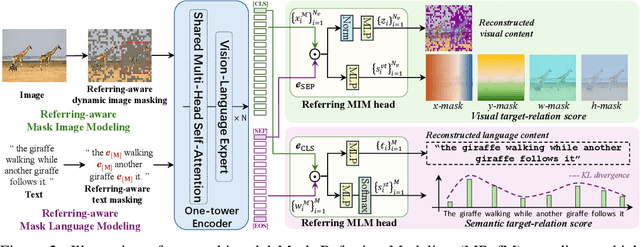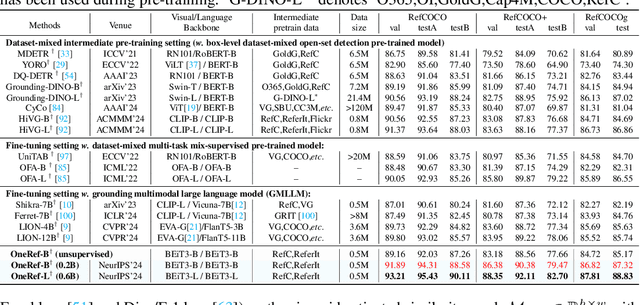Linhui Xiao
Towards Visual Grounding: A Survey
Dec 28, 2024Abstract:Visual Grounding is also known as Referring Expression Comprehension and Phrase Grounding. It involves localizing a natural number of specific regions within an image based on a given textual description. The objective of this task is to emulate the prevalent referential relationships in social conversations, equipping machines with human-like multimodal comprehension capabilities. Consequently, it has extensive applications in various domains. However, since 2021, visual grounding has witnessed significant advancements, with emerging new concepts such as grounded pre-training, grounding multimodal LLMs, generalized visual grounding, and giga-pixel grounding, which have brought numerous new challenges. In this survey, we initially examine the developmental history of visual grounding and provide an overview of essential background knowledge. We systematically track and summarize the advancements and meticulously organize the various settings in visual grounding, thereby establishing precise definitions of these settings to standardize future research and ensure a fair comparison. Additionally, we delve into several advanced topics and highlight numerous applications of visual grounding. Finally, we outline the challenges confronting visual grounding and propose valuable directions for future research, which may serve as inspiration for subsequent researchers. By extracting common technical details, this survey encompasses the representative works in each subtopic over the past decade. To the best, this paper presents the most comprehensive overview currently available in the field of grounding. This survey is designed to be suitable for both beginners and experienced researchers, serving as an invaluable resource for understanding key concepts and tracking the latest research developments. We keep tracing related works at https://github.com/linhuixiao/Awesome-Visual-Grounding.
OneRef: Unified One-tower Expression Grounding and Segmentation with Mask Referring Modeling
Oct 10, 2024



Abstract:Constrained by the separate encoding of vision and language, existing grounding and referring segmentation works heavily rely on bulky Transformer-based fusion en-/decoders and a variety of early-stage interaction technologies. Simultaneously, the current mask visual language modeling (MVLM) fails to capture the nuanced referential relationship between image-text in referring tasks. In this paper, we propose OneRef, a minimalist referring framework built on the modality-shared one-tower transformer that unifies the visual and linguistic feature spaces. To modeling the referential relationship, we introduce a novel MVLM paradigm called Mask Referring Modeling (MRefM), which encompasses both referring-aware mask image modeling and referring-aware mask language modeling. Both modules not only reconstruct modality-related content but also cross-modal referring content. Within MRefM, we propose a referring-aware dynamic image masking strategy that is aware of the referred region rather than relying on fixed ratios or generic random masking schemes. By leveraging the unified visual language feature space and incorporating MRefM's ability to model the referential relations, our approach enables direct regression of the referring results without resorting to various complex techniques. Our method consistently surpasses existing approaches and achieves SoTA performance on both grounding and segmentation tasks, providing valuable insights for future research. Our code and models are available at https://github.com/linhuixiao/OneRef.
HiVG: Hierarchical Multimodal Fine-grained Modulation for Visual Grounding
Apr 20, 2024Abstract:Visual grounding, which aims to ground a visual region via natural language, is a task that heavily relies on cross-modal alignment. Existing works utilized uni-modal pre-trained models to transfer visual/linguistic knowledge separately while ignoring the multimodal corresponding information. Motivated by recent advancements in contrastive language-image pre-training and low-rank adaptation (LoRA) methods, we aim to solve the grounding task based on multimodal pre-training. However, there exists significant task gaps between pre-training and grounding. Therefore, to address these gaps, we propose a concise and efficient hierarchical multimodal fine-grained modulation framework, namely HiVG. Specifically, HiVG consists of a multi-layer adaptive cross-modal bridge and a hierarchical multimodal low-rank adaptation (Hi LoRA) paradigm. The cross-modal bridge can address the inconsistency between visual features and those required for grounding, and establish a connection between multi-level visual and text features. Hi LoRA prevents the accumulation of perceptual errors by adapting the cross-modal features from shallow to deep layers in a hierarchical manner. Experimental results on five datasets demonstrate the effectiveness of our approach and showcase the significant grounding capabilities as well as promising energy efficiency advantages. The project page: https://github.com/linhuixiao/HiVG.
CLIP-VG: Self-paced Curriculum Adapting of CLIP via Exploiting Pseudo-Language Labels for Visual Grounding
May 15, 2023



Abstract:Visual Grounding (VG) refers to locating a region described by expressions in a specific image, which is a critical topic in vision-language fields. To alleviate the dependence on labeled data, existing unsupervised methods try to locate regions using task-unrelated pseudo-labels. However, a large proportion of pseudo-labels are noisy and diversity scarcity in language taxonomy. Inspired by the advances in V-L pretraining, we consider utilizing the VLP models to realize unsupervised transfer learning in downstream grounding task. Thus, we propose CLIP-VG, a novel method that can conduct self-paced curriculum adapting of CLIP via exploiting pseudo-language labels to solve VG problem. By elaborating an efficient model structure, we first propose a single-source and multi-source curriculum adapting method for unsupervised VG to progressively sample more reliable cross-modal pseudo-labels to obtain the optimal model, thus achieving implicit knowledge exploiting and denoising. Our method outperforms the existing state-of-the-art unsupervised VG method Pseudo-Q in both single-source and multi-source scenarios with a large margin, i.e., 6.78%~10.67% and 11.39%~24.87% on RefCOCO/+/g datasets, even outperforms existing weakly supervised methods. The code and models will be released at \url{https://github.com/linhuixiao/CLIP-VG}.
 Add to Chrome
Add to Chrome Add to Firefox
Add to Firefox Add to Edge
Add to Edge